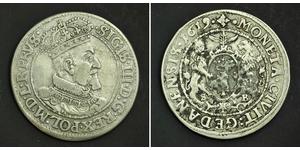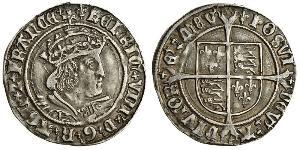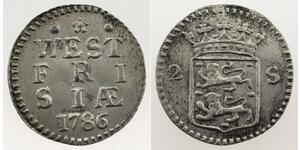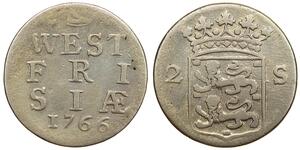(sold for $15.0)
1496, German States, Constance (Bishopric). Silver Batzen (4 Kreuzer) Coin. F-VF
Condition: F-VF Mint Period: 1496-1529 Reference: Schulten 1702. State: Bishopric of Constance Denomination: Batzen (4 Kreuzer) Emperor: Maximilian I of Habsburg. Bishop (Ruler): Hugo von Hohenlandenberg (1496-1532). Diameter: 27mm Material: Silver Weight: 3.52gm
Obverse: Shield with coat-of-arms of Bishop Hugo von Hohenlandenberg. Legend: * MONETA ° EPI ° CONSTANCIENSIS
Reverse: Heraldic eagle left. Legend: * MAXIMILIANVS ° ROMANORV ° REX
The Bishopric of Constance was a diocese of the Roman Catholic Church that existed from about 585 until 1821. Its seat was Konstanz at the western end of Lake Constance in the south-west corner of Germany. The diocese covered, in present-day borders, a large part of Switzerland, the largest part of Baden-Württemberg, and a small part of Austria.
Hugo von Hohenlandenberg (c. 1457 in Schloss Hegi bei Winterthur [Zurich] - 7 January 1532 in Meersburg, Germany) was Bishop of Konstanz from 1496 to 1529, and again in 1530/1531 until his death in 1532.
Hugo von Landenberg was born around the year 1457 in Oberwinterthur near Zurich. He was born into a wealthy aristocratic family which owned estates near Zurich. Like many younger sons from aristocratic families, Hugo entered the Church early in life.
His first known Church position came in 1484 when he was appointed provost of Saint Mary's at Erfurt. He was later a canon at Basel, Constanz, and Chur from 1486 until 1492, when he was promoted to deacon. The cities are on the border of modern Germany and Switzerland.
In October 1496 he was elected by the Cathedral Chapter of Konstanz as the new Bishop of the diocese. He was installed as Bishop in Konstanz on 18 December 1496.
He became bishop of Konstanz at a difficult time. The issue was due to increasing conflicts with the bishop of Konstanz, since 1506 increasingly in Meersburg.
He facilitated reforms in his diocese and did not interfere with the spread of Reformation ideas. Hugo was in agreement with the reformer Zwingli on a number of topics, particularly on indulgences, until the publication of two of the latter's works, Apologetic vs Archeteles Adpellat vs (Zürich, 1522) and a petition arguing against the need for priestly celibacy, when his opinions shifted dramatically. His response came swiftly in a short work defending the Church's position on celibacy, entitled "Ernstliche Ermanung des Fridensund Christenlicher Einigkeit des durchlüchtigen Fürsten unnd genädigenHerren Hugonis vo[n] Landenberg Bischoff tzu Costantz mitt Schönerusslegung unnd erklärung, vast trostlich unnd nutzlich zu lässen,nüwlich ussgangen" ((Augsburg), 1522/23).
The irony is that, according to the canon of Constanz, Johann von Botzheim, Hugo was romantically involved with a mayor's daughter. To cover this information and discredit its source, the bishop initiated an investigation of Botzheim for heresy for his reformist beliefs. Despite his best efforts, Hugo lost his battle against the rising tide of the Reformation as the Constanz reform movement steadily grew, and in 1526 Hugo and his chapter moved from the city to his castle at Meersburg, leaving the city to the followers of Martin Luther and Zwingli.
He resigned his see on 5 January 1529, but resumed his duties near the end of his life due to the untimely death of his successor to the see, Balthasar Merklin.
In retrospect Hugo von Hohenlandenberg can be grouped with contemporary Bishops of the Catholic Church such as Guillaume Briçonnet and Christoph von Utenheim who attempted, unsuccessfully, to reform the Church along evangelical lines without breaking up ecclesiastical unity.
Maximilian I of Habsburg (March 22, 1459 – January 12, 1519) was Holy Roman Emperor from 1508 until his death, but had ruled jointly with his father for the last ten years of his reign, from circa 1483. He expanded the influence of the House of Habsburg through both war and marriage, but also lost the Austrian territories in today's Switzerland in the battle of Dornach 22 July 1499, where the Swiss won a final decisive victory. King Maximilian I had no choice but to agree to a peace treaty signed on 22 September, 1499 in Basel granting the Swiss Confederacy de facto far-reaching independence from the Habsburgs. He is often referred to as "The Last Knight".
Maximilian was a keen supporter of the arts and sciences, and he surrounded himself with scholars such as Joachim Vadian and Andreas Stoberl (Stiborius), promoting them to important court posts. His reign saw the first flourishing of the Renaissance in Germany. He commissioned a series of three monumental woodblock prints - The Triumphal Arch (1512-18, 192 woodcut panels, 295 cm wide and 357 cm high - approximately 9'8" by 11'8½"), and a Triumphal Procession (1516-8, 137 woodcut panels, 54 m long) which is led by a Large Triumphal Carriage (1522, 8 woodcut panels, 1½' high and 8' long), created by artists including Albrecht Dürer, Albrecht Altdorfer and Hans Burgkmair.
Maximilian had appointed his daughter Margarete of Austria as both Regent of the Netherlands and the guardian and educator of his grandsons Charles and Ferdinand (their father, Philip, having predeceased Maximilian), and she fulfilled this task well. Through wars and marriages he extended the Habsburg influence in every direction: to the Netherlands, Spain, Bohemia, Hungary, Poland, and Italy. This influence would last for centuries and shape much of European history.

|
Posted by:
anonymous 2016-12-13 |
2 Stuiver Netherlands Silver
group has 33 coins / 33 prices
⇑
2 Gulden Free City of Frankfurt Silver
group has 72 coins / 71 prices
⇑
























